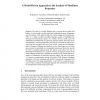Free Online Productivity Tools
i2Speak
i2Symbol
i2OCR
iTex2Img
iWeb2Print
iWeb2Shot
i2Type
iPdf2Split
iPdf2Merge
i2Bopomofo
i2Arabic
i2Style
i2Image
i2PDF
iLatex2Rtf
Sci2ools
ECMDAFA
2009
Springer
2009
Springer
A Model Driven Approach to the Analysis of Timeliness Properties
The need for a design language that is rigorous but accessible and intuitive is often at odds with the formal and mathematical nature of languages used for analysis. UML and Petri Nets are a good example of this dichotomy. UML is a widely accepted modelling language capable of modelling the structural and behavioural aspects of a system. However UML lacks the mathematical foundation that is required for rigorous analysis. Petri Nets on the other hand have a strong mathematical base that is well suited for analysis of a system but lacks the appeal and ease-of-use of UML. Design in UML languages such as Sequence Diagrams and analysis in Petri Nets require on one hand some expertise in potentially two incompatible systems and their tools, and on the other a seamless transition from one system to the other. One way of addressing this impediment is to focus the software development mainly on the design language system and to facilitate the transition to the formal analysis by means of a com...
| Added | 26 May 2010 |
| Updated | 26 May 2010 |
| Type | Conference |
| Year | 2009 |
| Where | ECMDAFA |
| Authors | Mohamed Ariff Ameedeen, Behzad Bordbar, Rachid Anane |
Comments (0)

